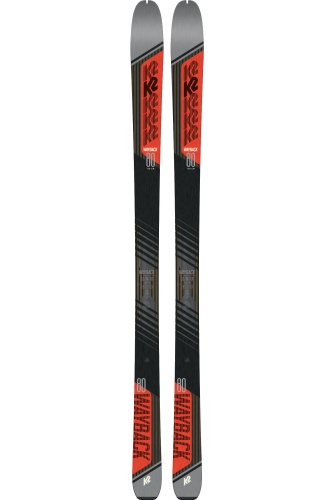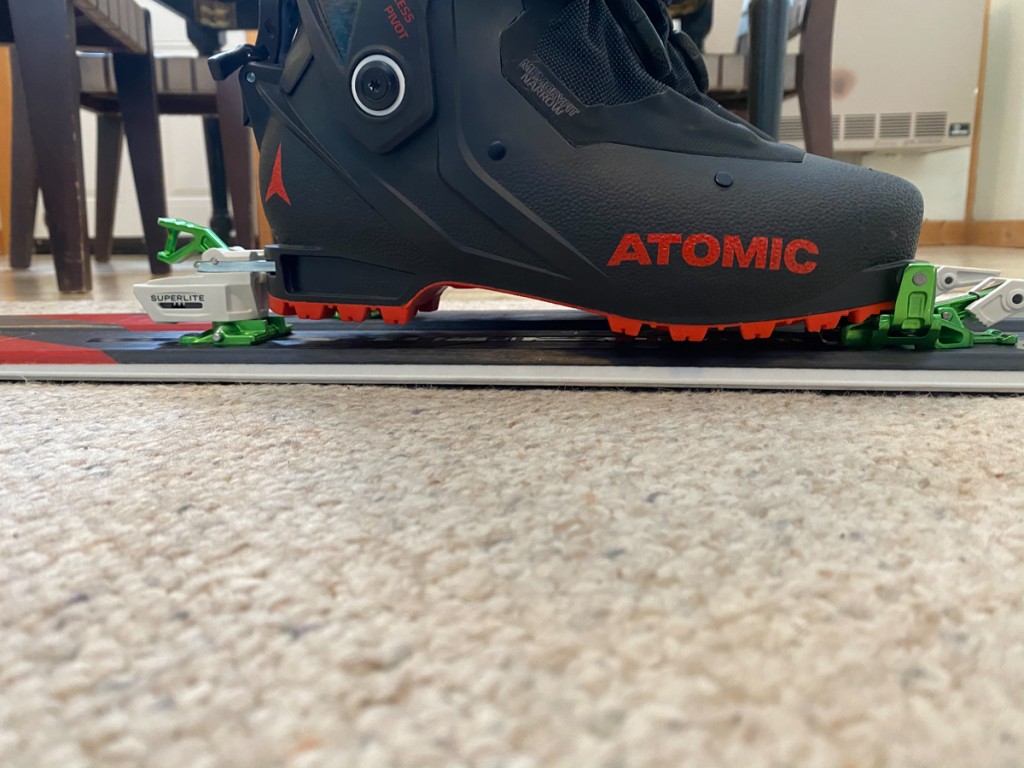K2 Wayback 80 Review
Our Verdict
Compare to Similar Products
 This Product
K2 Wayback 80 | |||||
|---|---|---|---|---|---|
| Awards | |||||
| Price | $900 List $612.00 at Amazon | $899.95 at Backcountry Compare at 2 sellers | Check Price at REI Compare at 2 sellers | $800 List $799.95 at Evo | $536.99 at Amazon Compare at 2 sellers |
Overall Score  |
|||||
| Star Rating | |||||
| Bottom Line | If your tastes tilt to the high, hard, steep, and fast, you need a pair of these | This relatively wide all-season ski is one of our favorites and great for all-around human-powered use | A high-performance, all-around backcountry ski for all types of wild skiing | Heavier skis that offer meaningful performance on the downhill, ideal for newer backcountry skiers or for experts who don't mind trading a bit of efficiency for a bit more fun | This affordable pair is great for a wide range of human-powered skiers and mountain conditions, with proven all-season downhill performance |
| Rating Categories | K2 Wayback 80 | Blizzard Zero G 105 | Atomic Backland 100 | Salomon QST Echo 106 | K2 Wayback 106 |
| Weight (25%) | |||||
| Firm Snow (20%) | |||||
| Powder (20%) | |||||
| Crud and Poor Snow (20%) | |||||
| Stability at Speed (15%) | |||||
| Specs | K2 Wayback 80 | Blizzard Zero G 105 | Atomic Backland 100 | Salomon QST Echo 106 | K2 Wayback 106 |
| Weight Per Pair (lbs) | 4.8 | 6.7 | 5.9 | 7.8 | 6.9 |
| Weight Per Pair (g) | 2185 | 3025 | 2661 | 3557 | 3075 |
| Weight Per Ski (g) | 1094, 1091 Average: 1093 |
1515, 1510 Average: 1513 |
1338, 1323 Average 1331 |
1784, 1773 Average 1779 |
1518, 1557 Average: 1537 |
| Weight Per Surface Area Ratio (g/cm²) | 0.63 | 0.72 | 0.64 | 0.8 | 0.71 |
| Measured Length (cm) | 177 | 178 | 178 | 180 | 179 |
| Manufacturer Claimed Length (cm) | 177 | 180 | 180 | 181 | 179 |
| Available Lengths (cm) | 163, 170, 177 | 164, 172, 180, 188 | 164, 172, 180, 180 | 157, 165, 173, 181, 189 | 172, 179, 186 |
| Measured Dimensions (mm) | 113/80/101 | 133/104/118 | 129/100/119 | 140/105/125 | 135/107/123 |
| Manufacturer Claimed Dimensions (mm) | 113/80/100 | 133/105/118 | 130/100/120 | 136/106/123 | 136/106/124 |
| Construction Type | Sandwich | Sandwich | Dura Cap Sidewall | Sandwich | Sandwich Cap Hybrid |
| Core Material | Paulownia, carbon, fiberglass, Titanal | Paulownia | Poplar and Caruba | Poplar and Caruba | Paulownia |
| Waist Width (mm) | 80 | 105 | 100 | 105 | 107 |
| Radius (m) | 18 | 23 | 19 | 16 | 22 |
| Rocker/Camber | All terrain rocker | Tip and tail rocker | Tip and tail rocker, camber underfoot | Tip and tail rocker, camber underfoot | Tip rocker, slight camber underfoot |
Our Analysis and Test Results
The K2 Wayback 80 is a solid little ski. At this point in history, skis this narrow will inherently fill a small niche. You're examining this ski, hopefully, for light, fast, and high missions. There are many things it isn't suitable for, but many cool endeavors that it is perfectly suited for. We choose skis like this for giant, multi-peak days of steep ski mountaineering. We choose skis like this for multi-day ski traverses. We choose skis like this for high-tempo training on your familiar uphill tracks. When we choose skis like this, we choose the Wayback 80. Paired with light boots and bindings, there is no better ski we've tested. In the aforementioned narrow niches, the K2 Wayback 80 is an excellent pair of skis. Its downhill performance transcends its tiny stature and light weight to deliver enjoyable (once the skier is adapted) performance in a variety of settings.
Performance Comparison
Weight
One kilogram has become a weight threshold of interest in backcountry ski gear. For both the boot and ski categories, around 1 kilogram (or roughly 2.2 lbs) is the line that divides uber ultralight "skimo" gear from more all-around kit. In the vicinity of one kilogram, again, whether boot or ski, you can get adequate downhill performance with mind-blowing uphill efficiency. Each tested K2 Wayback 80 weighs around 1090 grams. Or, for the metric-system challenged, 1.09 kg. That's about 2.4 pounds. That's less than your full, standard Nalgene one-liter water bottle.
We're talking super light ski gear here. Recently we enlisted the help of a new ski tester. The Wayback 80 is half the weight of anything he had used prior. He reported a significant (like, multiple days of touring) adjustment period to such light skis. These are unlike what you've used before, most likely. Your first uphill steps will be so different that you won't fully appreciate it. Your first downhill turns will take even more adjustment.
Once adjusted to the weight, though, you won't go back. The skeptical new tester just called to ask if he could use these K2 skis on an upcoming, high-consequence and committing trip to Europe. He'd choose these skis, at this feather-weight, for his only skis on an entirely different continent. That's perhaps enough endorsement.
Firm Snow
Of all the downhill situations you'll face in the backcountry, it is in firm snow that you experience the fewest compromises with the Wayback 80. Once your basic balance and weight distribution habits have adjusted to the mass and stature, the 80mm waist of the Wayback can be pressed to grip, carve, and turn predictably on all the flavors of hard and icy snow. As compared to big, wide, powder snow specialists, the Wayback 80 edges ahead. In those conditions (you listening, East Coast? California High Sierra? Springtime Northwest?), these narrow skis do better than skis weighing twice as much.
When you can win-win like that, with something as inherently as compromised as backcountry ski gear, we recommend you do so. In virtually all ski performance situations, weight is bad going uphill but good going downhill. Greater width brings greater weight. With the K2 Wayback 80 and firm or corn snow conditions, as compared to bigger, trendier, heavier skis, you can get super light weight and better downhill performance. Movers and shakers in the business, who have been watching trends for decades, note a few things.
Skis have gotten wider over the decades. BC skiing has gotten more crowded. The High Sierra of California (known for firmer snow) has "suffered" a smaller increase in crowding than other regions. It is one tester's opinion that the declining appeal of firmer terrain is due to gear trends. People try out firmer backcountry skiing on their heavy and soft-snow optimized BC ski gear, and don't like it. With narrower gear there in the high and hard, skiers would have more fun. That the narrower gear can be made so very lightweight is just a bonus.
Powder
It is logical to conclude that firm snow performance and powder performance are at odds. In some ways, this is true. But it isn't a perfect, mathematical "zero sum" game. In truly excellent powder snow, narrow skis are a darn blast to ride. Good snow is good skiing, regardless of your equipment. Our time in deep Teton powder snow on the Wayback 80 has been surprisingly enjoyable.
Narrow skis make short, wiggly powder turns more like you'd see in a 1980s Warren Miller movie than in a more current offering. Ski design does influence ski performance. But very little adversely affects powder skiing. Anytime you change gear, you need to make an adjustment. You'll have to adjust to the powder performance of the Wayback 80, but you'll enjoy it nonetheless.
Crud/Poor Snow
It's in tougher snow conditions that the Wayback 80 suffers. The narrow design and feathery weight gets pushed around by uneven, variable, and chunky snow. Deep "mashed potatoes", breakable crust, and tracked-up conditions will be tougher with the WayBack than with bigger skis. You can't get around this. You'll revert to survival-type turns when the snow gets tough.
Compared to bigger skis, the Wayback 80 suffers in tough snow, but compared to other skis of similar weight and dimension, it excels. It is the poor snow performance that really sets the Wayback apart. We've used and tested multiple models in this size and weight range, and the Wayback 80 definitely skis poor snow better.
Stability at Speed
You don't pick skis like this for stability. The narrow and feathery construction will wobble and chatter more than bigger options; it's inescapable. In terms of stability, weight is a performance attribute. More weight equals more stability. And these don't weigh much, as we glowingly observe above. High-speed stability suffers the most. Steep terrain stability is a slightly different story. In the steeps, the K2 Wayback 80 suffers the same low-mass issues, but the needle swings back to the plus side due to the narrow stature and super stiff construction.
Choose bigger skis if max-rate downhill skiing is your priority. With excellent technique and good snow, we are seeing our testers making slalom type turns, but not giant slalom turns, on the Wayback 80.
Should You Buy the K2 Wayback 80?
If you've gotten all the way through our review and are still considering the Wayback 80, you are probably a good candidate. For most, bigger skis are more appropriate, but for those that get out in a wide variety of settings and are building a quiver, something in this size and weight range is suitable. The Wayback 80 is a great, widely available choice in this range.
What Other Backcountry Skis Should You Consider?
In this subcategory of backcountry skis, the Wayback 80 is best compared to the Dynafit Blacklight Pro and the Movement Race Pro 77. They're all pretty darn similar in dimensions. The Dynafit is certainly more robust for serious and icy downhill skiing, while the Movement and K2 are both more forgiving. Between these two latter options, the Movement is slightly better in tough snow and a little bit lighter.














